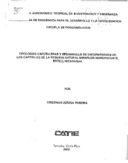Tipologías cafetaleras y desarrollo de enfermedades en los cafetales de la Reserva Natural Miraflor-Moropotente, Estelí, Nicaragua
Título alternativo
Coffee farm typologies and the development of coffee diseases in the Miraflor-Moropotente Nature Reservation, Estelí, Nicaragua
Descripción
Tesis (Maestría) - CATIE, Turrialba (Costa Rica), 2000 68 páginas 10 ilustraciones, 5 tablas 21.59 x 27.94 cm. Bibliografía páginas 44-50
Resumen
El trabajo se realizó en la reserva natural Miraflor-Moropotente ubicada entre las coordenadas (13° 3' 22'' y 13° 7' 30'' y 86° 29'15'' y 86° 29'50'') a 25 km de la ciudad de Estelí, 157 km al norte de Managua Nicaragua. El estudio abarcó 10.000 ha en esta área predomina el bosque de nebliselva y una gran variedad de microclimas. El objetivo del trabajo fue evaluar el desarrollo de enfermedades en los diferentes tipos de sombra de la reserva natural Miraflor Moropotente. Se estudiaron 40 fincas clasificadas como cafetales con sombra de bosque raleado, bosque raleado y musáceas, cafetales con Inga spp (guaba) y cafetales con musáceas. Se identificaron cinco tipologías cafetaleras: 1) cafetales con muchas especies maderables, en zonas altas, altos insumos (productores orgánicos); 2) con muchos árboles para leña, alta densidad de siembra y bajos insumos; 3) con muchas musáceas en el dosel, menos diversos, menor riqueza, menor densidad de plantación, y de bajos insumos; 4) cafetales con mayor porcentaje de sombra, mayor riqueza y menor Producción; 5) cafetales con cítricos y frutales como parte del dosel, los más diversos, mayor Producción y de bajos insumos. Las variables del dosel de sombra, del manejo, de la finca y el productor fueron importantes en la determinación de las tipologías cafetaleras. This study was carried out in the Miraflor-Moropotente nature reservation located between the coordinates 13° 3' 22'' and 13° 7' 30'' North Latitude and 86° 29'15'' and 86° 29'50'' West Longitude. The reservation is 25 Km from the city of Estelí and 157 Km north of Managua the capital of Nicaragua. The study site convers an area of 10.000 ha in wich the mountain forest dominates with a great variety of microclimates. The objective of the work was to evaluate disease development in the different types of shade of the Miralfor-Moropotente nature reservation. Forty coffee plantations were located and classified according to the shade type as: shade of managed forest, managed forest and musaceas, coffee plantations with Inga spp (guaba) and coffee plantations with musaceas. The variables, shade canopy, management, farm and producer, were important in the determination of the coffee typologies. Five coffee typologies were identified: 1) coffee plantations with many timber species, in high areas, high inputs (organic producers); 2) with many trees for firewood, high planting density and low inputs; 3) with many musaceas in the canopy, less diverse, less richness, less plantation density, and low inputs; 4) coffee plantations with greater shade percentage, greater richness and less production; 5) coffee plantations with citrus and fruits as part of the canopy, the most diverse, bigger production and low inputs.
Palabras clave
Editor
CATIE, Turrialba (Costa Rica)
URI (Enlace permanente para citar o compartir este ítem)
https://repositorio.catie.ac.cr/handle/11554/4631Colecciones
- Tesis [2911]


